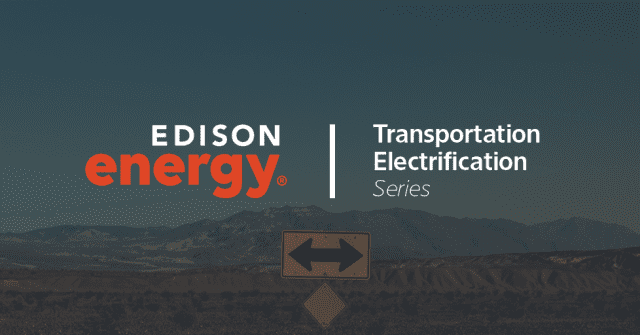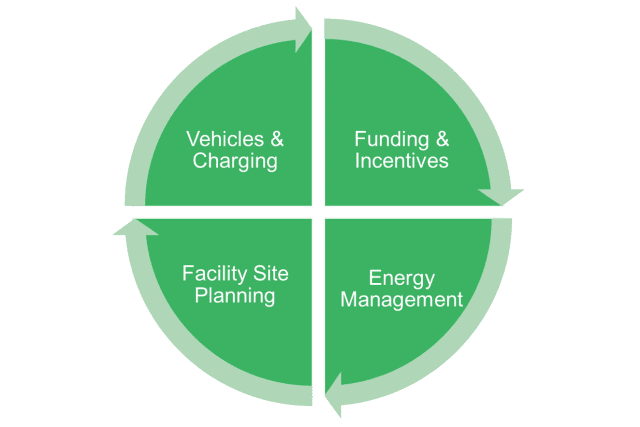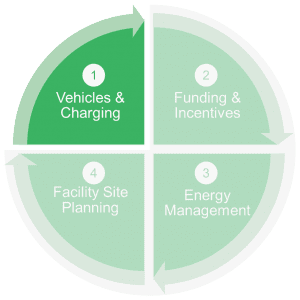
May 12, 2021
How to Accelerate Your Transportation Electrification Journey – Develop a Plan
By Ali Clunk, Sales Operations Analyst & Meghan Weinman, Director, Transportation Electrification

In the last post in our Transportation Electrification Series, we talked about how corporate sustainability is driving fleet electrification – and how transitioning to electric vehicles (EVs) provides a pathway towards significant carbon reductions. With the right plans and energy expertise, fleets that electrify not only benefit from lower carbon emissions but can also see significant cost savings. Each organization’s EV journey can look different – whether it includes fleet electrification or EV charging as an amenity. In this blog post, we will walk through some key steps to address when considering how to begin your roadmap to transportation electrification.
Where to start in your electrification roadmap:
Feasibility & Early Planning

Converting vehicles to electric takes thought and planning, and often those early details are the most important when making the transition. Electric vehicles are a new technology, which means that fleet and sustainability managers are navigating the complexities of switching to a new fuel – electricity. This includes new equipment, vehicle charging, facility preparation, and organizational planning. Trying to jump right into electrification can lead to common industry problems such as lack of space for charging infrastructure, purchasing the wrong equipment, or vehicles being unable to meet route requirements.
With many organizations having large and complex fleets across different vehicle types and locations, we’ve laid out the first initial steps to consider when electrifying. This can often be an iterative process, with each piece of information informing the ease or ability to electrify at a certain location. To make this seemingly overwhelming and daunting first step more manageable, we have broken down the process into 4 steps:


Step 1 – Assess vehicles and EV charging that fits business operations
One of the biggest pieces to think through in vehicle electrification is what type of vehicles will fit the needs of your organization and be comparable to traditional internal combustion engine (ICE) vehicles. This initial evaluation is to determine the driving patterns, distances, and usage of your current fleet routes, helping to provide an informed decision on EV selection.
In addition, knowing the driving patterns of your fleet will determine what speed of charging is required, and how often it’s needed. Having an idea of vehicles that fit business needs and the type and speed of your chargers will inform later decisions in Steps 2-4.
 Step 2 – Determine available funding and incentives
Step 2 – Determine available funding and incentives
Geography matters! This means picking a first facility or location to electrify that’s in a state or area with incentives or programs that can cover up-front costs. There are several available incentives and funding mechanisms from federal, state, or utility sources. Often there are electric vehicle programs that can cover vehicle costs, but also charging infrastructure. Utilizing these programs not only makes an easier business case but will allow you to electrify more of your fleet down the road.
 Step 3 – Develop an energy management strategy
Step 3 – Develop an energy management strategy
Switching to electricity as a vehicle fuel can save money – if managed correctly. When selecting vehicles and charging speeds, it is essential to determine daily power requirements. Early and proactive energy management can ensure that fleet and charging station operators don’t end up with an unexpected electricity bill later. This means planning EV charging in a way that optimizes electric utility rates and determining electric load management strategies early. This can also include planning for the additional electric supply or determining whether to use renewable energy resources. Unlike gasoline or diesel fueling, electricity costs can vary throughout the day, which can add variability to overall costs if not managed effectively.
 Step 4 – Determine site feasibility
Step 4 – Determine site feasibility
Determining where at a facility or building EV charging infrastructure will be installed matters. This means initially working with the electric utility to ensure there is adequate power at a site. Charging stations should also be planned in configurations that work with your facility’s existing space, support current and future operations, maximize equipment lifecycles and control costs.
Edison Energy takes a flexible approach to helping our clients transition to EVs. Our technical advisory helps clients build a business case for fleet conversion, and our deep expertise supports electrification through EV infrastructure implementation. Edison knows that there is not a one size fits all approach to carbon reduction, energy needs, or transportation electrification, and we assist clients at any stage. We help answer the key questions stated above, and more.
Contact Edison Energy today to learn how transportation electrification can help your organization reach its sustainability goals and achieve cost savings!
Check back in our Transportation Electrification Blog Series where we will cover more topics such as the business case (or return on investment) from electrifying vehicles and charging in future, industry terms you need to know, and more!




